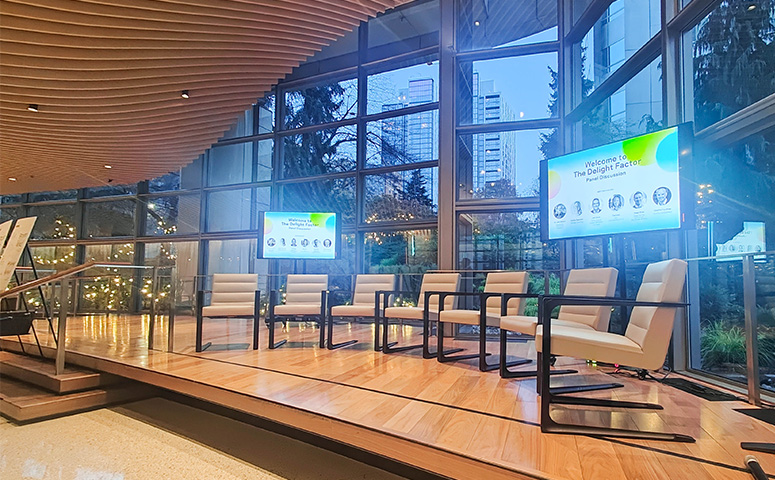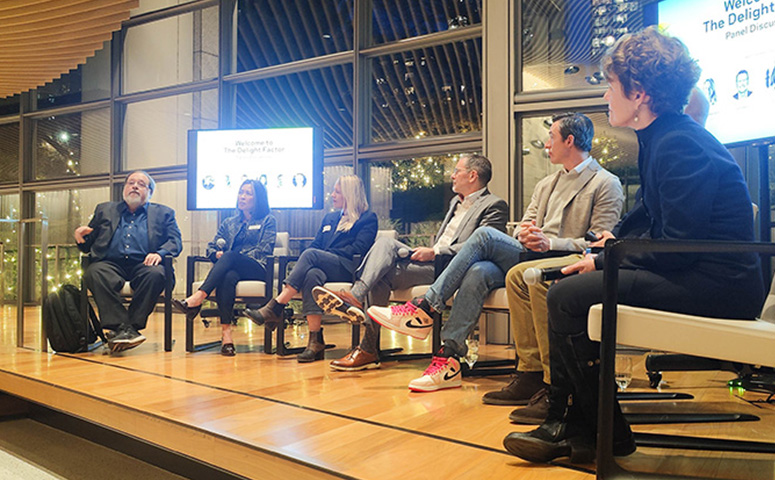Can an office be more than a functional space for performing work? Can it be a place that through its intentional design and natural elements inspires groundbreaking ideas and discoveries? Can it even evoke joy?
These were the questions under consideration at The Delight Factor, a panel discussion hosted by ideas-driven design firm NBBJ Design. Creating spaces that generate joy–that have what the firm calls a “delight factor”—is a core part of NBBJ’s mission. NBBJ has helped with projects across the globe that showcase this very idea. It’s reflected in a behavioral health facility they designed in Monterey, California, for Montage Health that embraces the outdoor environment, relies on natural materials like cross-laminated timber, and incorporates gardens and beautiful staff areas designed to reduce staff burnout and turnover. It includes LinkedIn’s global headquarters in Sunnyvale, California–a unique campus they designed with diverse and connected stations–modern, airy coworking spaces, a coffee shop and cafeteria, outdoor tables, and living room areas for drawing people together and fostering collaboration.

At the discussion, Owen Rice, executive vice president at Hughes Marino, spoke as part of a panel that included a developer, a project manager and leaders with the Fred Hutchinson Cancer Center and the Allen Institute for Brain Science.
Rice noted that across all industries, companies are focused on ways to draw employees back to the office and are looking for ways to retain top talent. The quality of the office environment has never been more important.
“As someone who represents companies, I’m a firm believer that if we provide an exceptional work environment, we can bring people back to the office without coercion,” he says. “They will be drawn of their own volition.”
At Hughes Marino, we aim to walk the talk with our own inspiring office spaces–including our Seattle office with its breathtaking views of Mt. Rainier to the Olympic Mountains and Puget Sound, its gourmet kitchen and farm table for impromptu gatherings, its bright, color-popping modern art and inviting living room spaces.
Rice says firms like NBBJ and Hughes Marino are approaching the work environment through an entirely new lens. While offices need to be functional spaces, he says, they also need to reflect the mission and culture of the company; to inspire collaboration and the kind of spontaneous breakthroughs that can only happen in person. In addition, yes, they even need to spark joy!
“If the office isn’t superior to the comforts of home, what incentive do people have to willingly return?” Rice says. “When office space is uninspiring, attendance is met with a lot of reluctance. We need to understand the value of real estate based on the satisfaction and attendance levels of team members.”

The event’s keynote speaker, John Medina, the author of the bestseller Brain Rules and a professor at the University of Washington, provided insights into how our brains respond in various environments and the conditions under which we achieve optimal performance. These include natural elements like trees, green space and sunlight; the ability for movement, bright, inviting colors and quiet spaces.
“If you are in a space more conducive to learning and working, your output will be much higher,” says Rice.
The panel discussion presented an opportunity to reframe the way we view workspaces and seize this return-to-office moment to offer a different approach–one that will benefit team members’ wellbeing and productivity and business’ bottom line.
The mindset shift around workplaces is long overdue, Rice says. “For too long, corporate America evaluated spaces based on the cost of real estate per person,” says Rice. “How much it costs per square foot, and how many square feet are allocated per person. The focus was on driving savings and not on the delight. But if you pay your employees handsomely and those people are just 1% more productive because of better space, that output far outweighs those real estate savings.”








